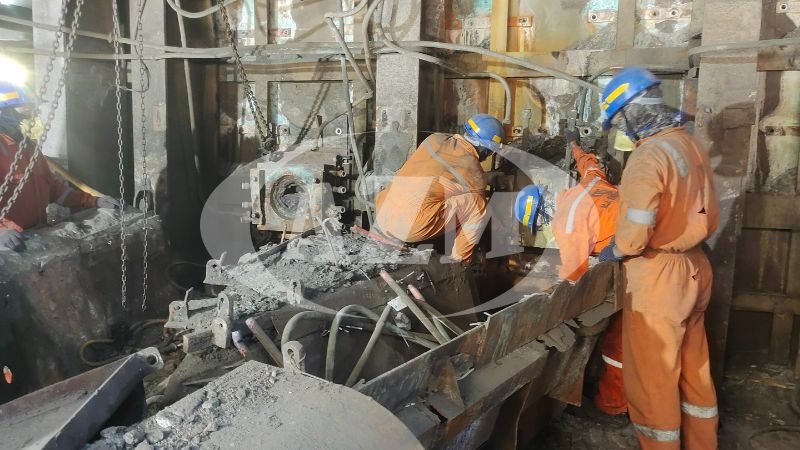Each smelter process not only goes through one smelting process but also goes through many processes and tools used in smelting such as slag leaning, copper molding, and others. In the furnace process, each tool and process has its function. The following are examples of the types of furnaces used in mineral processing plants:
- Smelting furnace
A smelting furnace is a tool used in the metal smelting process. The way this tool works is as follows:
The dried concentrate and additional materials such as silica sand are fed into the smelting furnace through a lance (pipe) and oxidized with oxygen-enriched air which will produce a matte melt and slag. This melt will come out of the smelting furnace and enter the CL-Furnace through the launder.
- Slag Cleaning Furnace (CL-Furnace)
CL-Furnace is a furnace used to clean slag produced during the metal smelting process. Slag is an unwanted material residue that is separated from the main metal during the smelting process. The way this tool works is that the CL-Furnace is heated with 2 sets of delta-type electrodes (2100 & 1500 kVa). Matte separates with slag due to the difference in specific gravity. The slag is granulated with pressurized water and sold to the cement industry. Meanwhile, the matte melt (Cu 68%) continuously comes out through the shipon and flows into the C-Furnace through the launder.
- Converting Furnace (C-Furnace)
Converting Furnace is a type of furnace used in metallurgical processes to change the chemical composition of liquid metal, generally to remove impurities and modify metal properties to achieve certain specifications. This process often involves the conversion of a raw metal or semi-finished product into a purer or higher quality metal form. The way this tool works is as follows:
The matte melts and the supporting material, namely limestone, will react with oxygen-enriched air and form blisters and slag. The slag (Cu 14%) will be returned to the S-furnace and C-furnace, and the blister will come out through the shipon line and will enter the anode furnace for further processing.
- Anode Furnace
Anode furnaces play an important role in ensuring that the metal used in the electrolysis process is of the quality necessary to produce pure metal and a final product that meets industry specifications. The way the Anode furnace works is as follows:
The blister previously processed from the C-Furnace is inserted into one of the 3 anode furnaces using a switching launder system. In this furnace, oxidation, and reduction reactions take place to produce copper that is ready to be molded.
- Hazelett Caster
Hazelett Caster is a technology in the metal casting industry that is used to produce billets (steel billets) or slabs continuously with high efficiency. This system is designed to produce metal products with good quality and consistency through a continuous molding process. The way this tool works is as follows:
The copper that has been purified using an anode furnace will then be cast continuously into the Hazelett Twin Belt Caster to form copper plates. The plate is continuously cut into an anode with a hydraulic shearing machine.
Making these types of furnaces requires special labor and materials, which you can get from PT Aldzama. Apart from providing labor and material supply services for the installation and demolition of furnaces, PT. Aldzama also provides furnace refractory dry-out and heating services, providing maximum seamless service with our strategic alliance to maximize the performance of your furnace. By ensuring even heat distribution throughout the refractory layer, we increase the durability and efficiency of the furnace. The use of PT Aldzama’s services has been used by several large clients such as PT. Freeport Indonesia, PT Vale Indonesia, PT. Gresik Smelting.
Reference:


